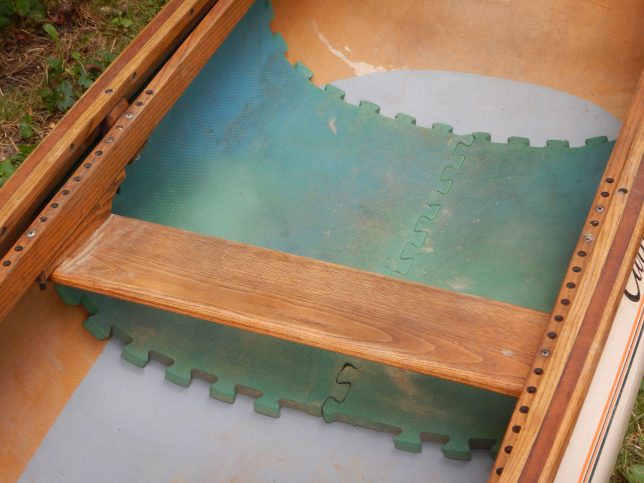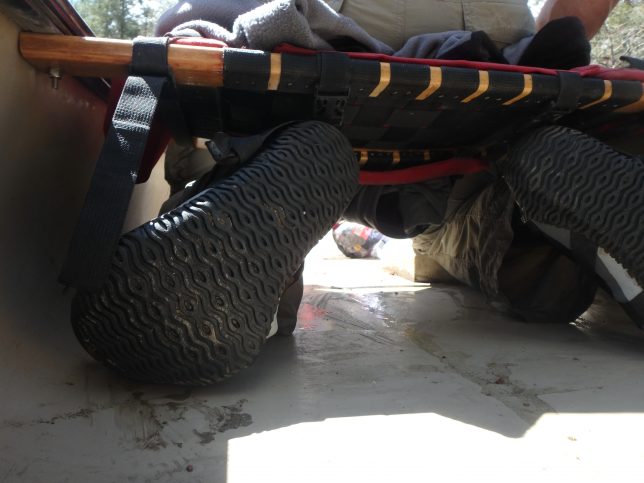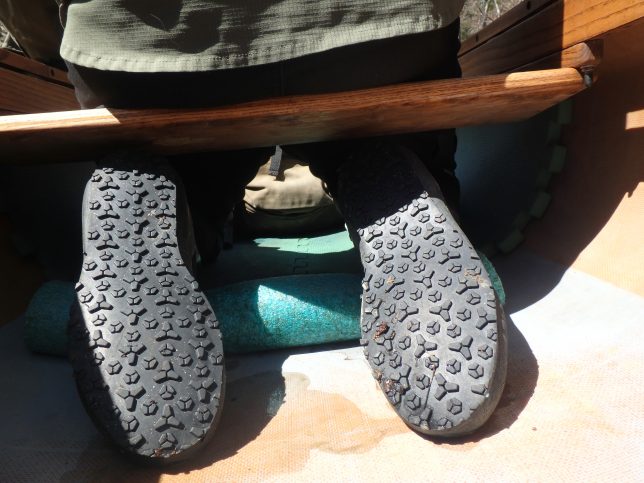KNEELING IN COMFORT
by Tim Burris
I’ve been a fan of kneeling in canoes for a long time. For me, kneeling is more comfortable for a few reasons: less lower back tightness; an enhanced ability to move around in the canoe; and a higher viewpoint. But kneeling isn’t for everyone. I can’t sit in a pack canoe, for instance, or even just sit on the floor for more than 45 minutes before my back revolts, so I totally get individual limitations, and can empathize with people who cannot kneel.
There are advantages to kneeling over sitting in a canoe, but I will speak of those in more detail in Part 2 of this series. In this first Part, I want to talk about simply making kneeling more comfortable. Let us assume you can kneel, but you’ve never felt comfortable doing it in a canoe for long periods. Possibly it hurts to kneel for more than a few minutes. Here are a few tips that might help.
Kneeling Pads
A quality kneeling pad is a big start to finding comfort while kneeling. I started out as a teen in a chopper gun fiberglass canoe, and probably still have fiberglass threads in my knees 50 years later. I trash picked a square foot sample of shag carpet that was great. It was always wet, but it made kneeling so much more comfortable. I can’t imagine ever being comfortable kneeling if I didn’t have a good pad. My first commercial pad was a 9” x 31” strip of foam with a non-slip cover. That was okay, but now I prefer something that extends under the canoe seat to also pad my ankles and feet.

Good pads can be simple. I have friends that use the interlocking foam mats that are used on shop floors and playrooms. They are basically non-slip, so you can put a few together to form your pad. You can also easily customize the size and shape with a utility knife, and conform it such that it will wedge securely into place under the gunnels. Gardening pads, yoga mats, all sorts of things will pad your knees and make things more comfortable in a canoe. I want a smooth pad so I can easily reposition, and something that won’t tear up my knees.
I don’t glue my pads in my boat because I like to be able to dry and clean them. I remove the pad and give it a good shake occasionally which gets rid of the sand and twigs. I can also hang it up at night, or drape it over the canoe to dry in the sun.

Northstar Canoes sells a great kneeling pad. https://northstarcanoes.com/accessories/canoe-gear/ Their Knee Pad has lots of cushion. Their Trapezoid Pad is even better and extends under the seat to cushion my ankles and feet. In my opinion it is the best canoe pad being made now. The foam is luxurious and comfy. That said, every canoeist will tell you that theirs is the best pad based on their own opinion and knees. It’s a very individual preference.
A canoe pad can make a big difference for people when it comes to kneeling comfortably in a canoe. You should give a kneeling pad a try if you have never used one.
Seat Height
Seat height is probably the next thing that you should examine if you aren’t comfortable kneeling. Most canoe seats are set up for sitting paddlers. The seats are hung low to lower the center of gravity. They are almost always too low for me to comfortably kneel. I can’t get my feet in and out from under the seat very easily at all. This could lead to an entrapment issue, but it is also just plain uncomfortable.

The big thing concerning comfort with low seats is leg angles. I recently raised the seat in one of my canoes. My legs were bent too tightly (my calves were too close to my thighs). It was such a tight angle that circulation behind the knee would eventually get cut off. I had plenty of room under the seat, but very soon my legs would just get “tired”. To experiment, I used “gardener’s pads” to raise my bottom up higher. Just raising up ¾” made a big difference, but 1.25” was even better. I waited to cut the seat hangers until after I determined the right height. Now, I’m able to stay kneeling for longer periods without having to stretch. Moving from kneeling to sitting also became easier with the higher seat.
Even though I am kneeling, most of my weight is resting on the seat. This is important. Yes, you are kneeling, but your weight isn’t on your knees most of time. If your seat isn’t set up so that you can transfer your weight around, then you will be uncomfortable kneeling. I like my seat to be canted just a bit forward, but I have friends that argue a flat seat is better.
Changing the seat height and even canting the seat can take a lot of stress off your legs and that makes kneeling more comfortable.
Footwear
Just like leg angles, the angle of your ankles under the seat can have a huge impact on comfort. Footwear influences this angle more than anything. I’m not a big fan of going barefoot while kneeling. (I once – and only once – sunburned the soles of my feet that way.) So, I wear thin sock liners and take off my footwear when I’m settled in the canoe.
Obviously, if you are in and out of your canoe for beaver dams, blowdowns, or portages you need something that stays on your feet and is also reasonably comfortable when kneeling. Everyone is different. I have lots of friends who swear by water sandals. For me, the stiffness of the soles puts too much pressure on my feet and ankles. For the same reason I couldn’t get by with sneakers. But if they don’t bother your ankles, go for it. I can get by with Crocs, but I usually slide them off when I’m in the boat.
For cold weather or rougher landings, I often wear the soft soled high top canoe boots. The hard soled high-tops don’t work for me because my foot can’t bend, but even the soft sole version will bother my ankles eventually.

For those of us who have difficulty hyperextending our ankles for any period of time, a pool noodle, stuffed under the ankles, is an option; it elevates the ankle off the bottom of the canoe and provides some cushioned support. Pool noodles do tend to get somewhat crushed, so you may try slipping a piece of PVC pipe through the middle of the pool noodle, to give it more stiffness. For even firmer support, a piece of dense foam, like that used to outfit whitewater canoes, cut into the size and shape that’s just right for you, is another, more durable, option. Gluing any of these ankle support options in place is not recommended… this will make it harder to get your feet into position, and can also cause foot entrapment.
Lately I’ve been trying the shorter soft soled “booties” and find they work very well for me because they don’t stress my ankles as much. But the trouble with short booties is you are always stepping into water over the tops. That may be okay in the summer, but not from October to April. My solution was to buy stocking-foot dry pants and wear the short booties. Now I can jump into the water, up to my waist if necessary, and stay dry, and my ankles don’t get sore.
Finding the right footwear has a lot to do with kneeling comfort. There are tons of threads about footwear on the canoe forum message boards and everyone has an opinion about what is the absolute “best”. Me? I have a tote box full of different types of footwear for different conditions. Finding the right combination for the circumstances and what is comfortable for kneeling is an ongoing task worthy of personal exploration.
Stretching/Exercise/Yoga
Staying flexible is the final piece of the puzzle for me. We have talked about making adjustments to the equipment to make it more comfortable to kneel. We need to talk about making adjustments to our bodies too. I do stretches all year to make work and play more comfortable. As I age, I find those morning stretches and exercises are crucial to my comfort throughout the day. In the off season I have special exercises I do to keep my legs in shape for kneeling in my canoe. So, talk to your doctor, trainer, or yoga instructor. Find the exercises that help increase leg circulation, and strength – and do them.
To recap: Kneeling pads, seat height, footwear and stretching are all things that can make kneeling in your canoe more comfortable. A Canoe Symposium, Rendezvous or Demo Day is a great place to try canoes with different seat heights and angles. They are also the place to talk to people about pads, footwear and exercise. In the next installment, I will talk about the different advantages to kneeling over sitting.